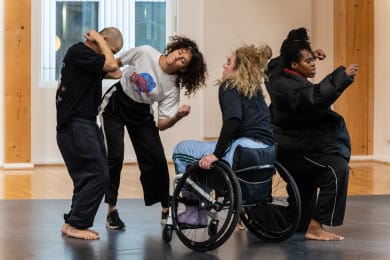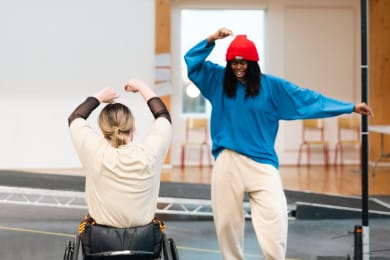Postcards from the Studio, Week 5

We are back in rehearsals for our commission Over and Over (and over again) with Dan Daw Creative Projects and Stef O’Driscoll. For the next few weeks we’ll be based at Clod Ensemble, ‘Cripps Yard’ which feels fitting for a company and creative team who celebrate Crip identity and culture!
For those of us less familiar with this language, Crip is a term reclaimed in disability culture. It celebrates disabled knowledges, lived experience and ways of being in the world.
For me personally, Crip has an energy, and an edge, a naughtiness and playfulness that I find really useful when imaging spaces and systems differently. For example when imagining how to bend the system to the Crip body, rather than the other way around, something we are working hard to do in this rehearsal process with paid rest days and rest integrated into the studio and the piece.
But today I wanted to write a little about the themes and content of the show, of what we are exploring about dance as a freedom practice. Or as Emma Warren writes in ‘Dance Your Way Home’, how to get from ‘fortress to freedom’:
“Your body might feel like a fortress holding stresses caused by hostile or traumatic experiences, in which case dancing can allow you to shake off at least some of that armour. The fortress might be the world outside, keeping you out. Either way, the right music in the right environment can allow a person to move the constraints. To Exhale”
McKenzie Wark puts it a different way in ‘Raving, A Practice’. They write: “For 20 beats the world is ours”.
I love this last phrase. It speaks to me of something fleeting, yet precious and important. In the research for this show I am learning about rave as a collective practice to imagine the worlds we need to survive. I’m learning about people creating these temporary, fleeting sites for collective movement that reach for something different – a feeling, a togetherness that is not enabled, or is actively repressed by our structures.
This week we watched a documentary on rave called ‘Better Days: the Story of UK Rave Culture (on Amazon)’. As we dive into the material and talk about freedom, we are also talking about the times we’ve been excluded from the dance. For those of us who crave rest as well as rave, the dancefloor has felt out of reach for us. I feel an excitement in exploring an alternative rave that allows for all ways of being, and there is a tenderness for me around when that’s not possible.
I’ve also had the pleasure to watch Dan and Stef sketch out a score for the first 15 minutes of the show. It was fascinating to learn more how Dan sets material through repetition: a score will be repeated and defined or distilled through repetition. Dan talked about this as “collectively finding the material”. In one repetition we found that the dance had come to stillness too soon, and that one dancer needed a moment (maybe a solo?) there. Dan acknowledged that repetition can be exhausting, and welcomed the company to say “I’ll walk it through this time” or “Can we talk it through this time”. As someone who has spent many hours trying to put ‘one move after another’ in the traditional way of setting material, witnessing this methodology felt like a breath of fresh air.
More next week,
Raquel
With the support of Dance Reflections by Van Cleef & Arpels.
This commission was also supported by Arts Council England, and Cockayne Grants for the Arts, held at The London Community Foundation.
Please head to our Over and Over (and over again) page for more information about this work, the confirm dates and for the full list of credits.








